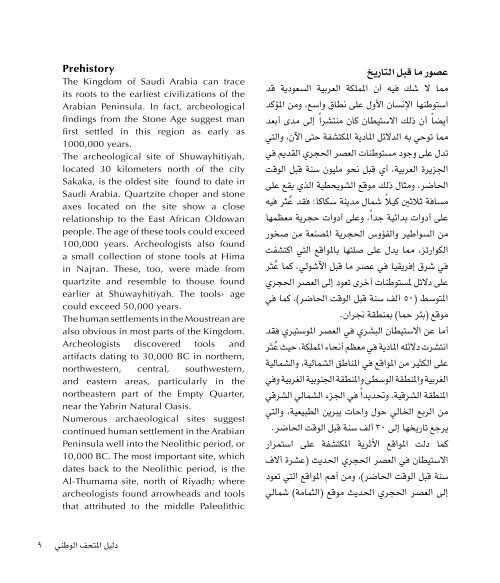Museimguide
Museimguide
Museimguide
You also want an ePaper? Increase the reach of your titles
YUMPU automatically turns print PDFs into web optimized ePapers that Google loves.
PrehistoryThe Kingdom of Saudi Arabia can traceits roots to the earliest civilizations of theArabian Peninsula. In fact, archeologicalfindings from the Stone Age suggest manfirst settled in this region as early as1000,000 years.The archeological site of Shuwayhitiyah,located 30 kilometers north of the citySakaka, is the oldest site found to date inSaudi Arabia. Quartzite choper and stoneaxes located on the site show a closerelationship to the East African Oldowanpeople. The age of these tools could exceed100,000 years. Archeologists also founda small collection of stone tools at Himain Najran. These, too, were made fromquartzite and resemble to thouse foundearlier at Shuwayhitiyah. The tools› agecould exceed 50,000 years.The human settlements in the Moustrean arealso obvious in most parts of the Kingdom.Archeologists discovered tools andartifacts dating to 30,000 BC in northern,northwestern, central, southwestern,and eastern areas, particularly in thenortheastern part of the Empty Quarter,near the Yabrin Natural Oasis.Numerous archaeological sites suggestcontinued human settlement in the ArabianPeninsula well into the Neolithic period, or10,000 BC. The most important site, whichdates back to the Neolithic period, is theAl-Thumama site, north of Riyadh; wherearcheologists found arrowheads and toolsthat attributed to the middle Paleolithicتقع المملكة العربية السعودية في الركن الجنوبيالغربي من قارة آسيا، وتحتل موقعاً استراتيجياً بينقارات العالم، وتتفاوت المظاهر الطبيعية فيها، حيثتمتد السهول الساحلية في الغرب على ساحل البحراألحمر، وتحف بها جزر وأرصفة مرجانية، تليهامرتفعات جبلية تمثلها جبال السروات في الجنوب،وجبال الحجاز في الشمال، وتضم هضبة نجد فيالوسط سلسلة جبال طويق، إضافةً إلى جبال أجاوسلمى في منطقة حائل.وتمثل الصحاري الرملية الجزء األكبر من مساحةالمملكة التي تتمثل في صحراء الربع الخالي فيجنوب المملكة، وصحراء النفود في شمالها، إضافةًإلى صحراء الدهناء التي تقع في شرق البالد، وتليهاواحات األحساء والقطيف ثم شواطئ الخليج العربي.وذكرت المصادر التاريخية الكثير من المعلوماتعن المواقع األثرية والتاريخية في المملكة العربيةالسعودية، كما كان لظهور األبحاث العلمية المنظمةعن آثار المملكة العربية السعودية دور في إلقاء الضوءعلى معلومات جديدة ومهمة عن الجزيرة العربية بشكلعام، والمملكة بشكل خاص. هذا إضافةً إلى أعمالالمسح األثري والتنقيب التي قام بها قطاع اآلثاروالمتاحف وعدد من الجامعات الوطنية، إلى جانبالمعلومات والبيانات اإلحصائية، ونتائج الدراساتالتي تجسد شبكة العالقات الحضارية الواسعة التيشهدتها البالد السعودية في تاريخها مع الحضاراتالقديمة في المناطق المجاورة.عصور ما قبل التاريخمما ال شك فيه أن اململكة العربية السعودية قداستوطنها اإلنسان األول على نطاق واسع، ومن املؤكدأيضاً أن ذلك االستيطان كان منتشراً إلى مدى أبعدمما توحي به الدالئل املادية املكتشفة حتى اآلن، والتيتدل على وجود مستوطنات العصر احلجري القدمي فياجلزيرة العربية، أي قبل نحو مليون سنة قبل الوقتاحلاضر، ومثال ذلك موقع الشويحطية الذي يقع علىمسافة ثالثني كيالً شمال مدينة سكاكا؛ فقد عُثر فيهعلى أدوات بدائية جداً، وعلى أدوات حجرية معظمهامن السواطير والفؤوس احلجرية املصنعة من صخورالكوارتز، مما يدل على صلتها باملواقع التي اكتشفتفي شرق إفريقيا في عصر ما قبل اآلشولي. كما عُثرعلى دالئل ملستوطنات أخرى تعود إلى العصر احلجرياملتوسط )50 ألف سنة قبل الوقت احلاضر(، كما فيموقع )بئر حما( مبنطقة جنران.أما عن االستيطان البشري في العصر املوستيري فقدانتشرت دالئله املادية في معظم أنحاء اململكة، حيث عُثرعلى الكثير من املواقع في املناطق الشمالية، والشماليةالغربية واملنطقة الوسطى واملنطقة اجلنوبية الغربية وفياملنطقة الشرقية، وحتديداً في اجلزء الشمالي الشرقيمن الربع اخلالي حول واحات يبرين الطبيعية، والتييرجع تاريخها إلى 30 ألف سنة قبل الوقت احلاضر.كما دلت املواقع األثرية املكتشفة على استمراراالستيطان في العصر احلجري احلديث )عشرة آالفسنة قبل الوقت احلاضر(، ومن أهم املواقع التي تعودإلى العصر احلجري احلديث موقع )الثمامة( شماليSaudi Arabia is located in the southwest corner ofthe Asian continent. Geographically, it lies at thecrossroads of Europe, Asia, and Africa. The landscapeof Saudi Arabia is outstandingly beautiful and diverse-- from the Red Sea coast and its magnificent coralreefs, to the Sarawat Mountains in the west, from theHejaz Mountains in the north, to the east of Hejaz,with the great plateau of the Najd, where the maintopographical features are the Tuwaiq Mountainrange and the Twin Mountains of Aja and Salma inthe north near Hail.The majority of the Kingdom of Saudi Arabia consistsof semi-deserts and deserts dotted with oases. In thesouth is the Rub› Al Khali Desert -- the biggest massof sand on the planet -- with An-Nafud Desert in thenorth, and Ad-Dahna Desert in the east, followed bythe oases of Al-Hasa and Qatif, and the coast of theArabian Gulf.But for many centuries, Saudi Arabia had acted as aliving museum, with its treasures buried under sands,forgotten. After Saudi and foreign archaeologistsbegan to uncover and explore cities and trade routeslong lost to the desert, the significance and extent ofSaudi Arabia›s rich archaeological heritage began tobecome clear.The Arabian Peninsula in general and Saudi Arabia inparticular has a long and fascinating history. In pre-Islamic times, the Arabian Peninsula was consistedof small kingdoms and crosseroads by caravanroutes to the Mediterranean, creating a situation inwhich ancient Arab peoples -- Nabateans, Lihyans,the Thamud -- interacted with Assyrians, Romansand Persians.دليل املتحف الوطني 98


